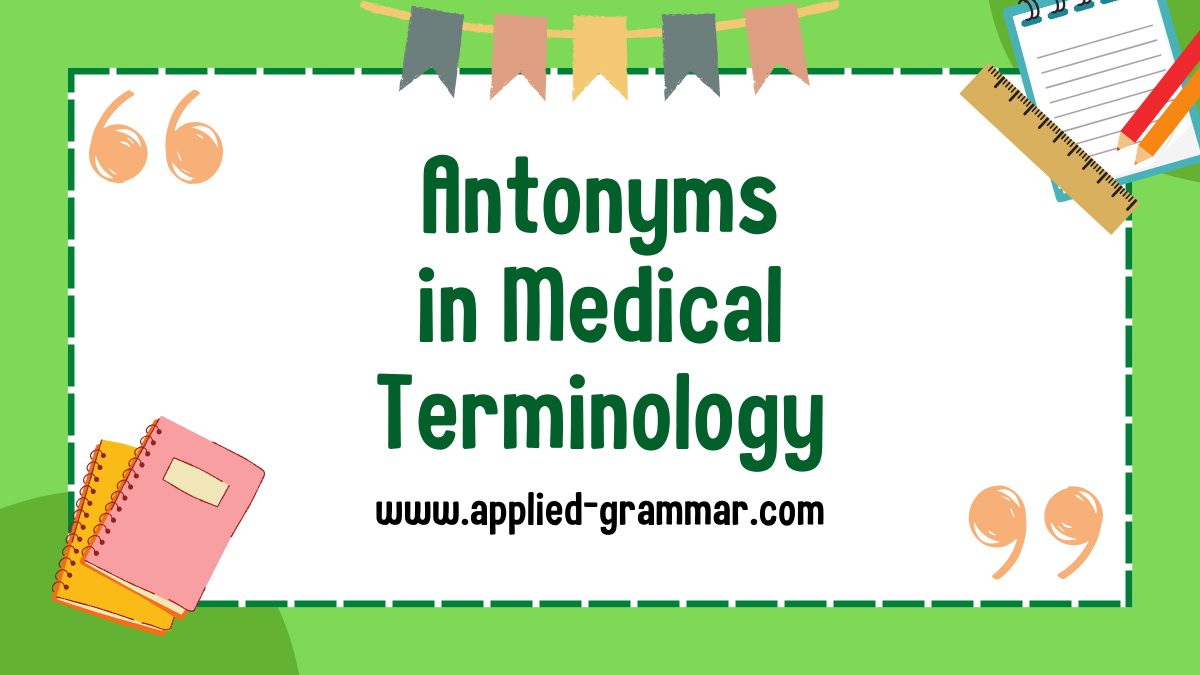Are you familiar with the concept of antonyms? These are words that have opposite meanings. But did you know that antonyms play a crucial role in medical terminology as well? Understanding the opposites in healthcare can help you navigate the complex world of medical terms with ease.
In the field of medicine, antonyms are used to describe contrasting conditions, symptoms, or treatments. For example, the antonym of “healthy” is “diseased,” and the antonym of “well-being” is “illness.” By understanding these opposites, you can better comprehend medical discussions, diagnoses, and treatment plans.
Key Takeaways
- Antonyms play a crucial role in medical terminology, helping describe contrasting conditions, symptoms, and treatments.
- Understanding antonyms in medical terminology allows for precise communication, clear documentation, and enhanced patient understanding.
- Antonyms prevent misinterpretation in medical discussions and assist in conveying information accurately.
- Common antonyms in medical terminology include hot/cold, on/off, increase/decrease, positive/negative, and day/night.
- Understanding antonyms is achieved through considering context and usage, recognizing prefixes and suffixes, and mastering root words and combining forms.
- Examples of antonyms in medical terminology include hyperactive/hypoactive, hypertension/hypotension, and hyperglycemia/hypoglycemia.
What are Antonyms in Medical Terminology?
In the field of medicine, antonyms play a crucial role in describing contrasting conditions, symptoms, or treatments. By understanding these opposites, you can better comprehend medical discussions, diagnoses, and treatment plans.

Definition of Antonyms
Antonyms are words with opposite meanings. They provide a clear contrast and help convey different aspects of a medical term. For example, in medical terminology, the antonym of “healthy” would be “unhealthy.”
Understanding antonyms in medical terminology is essential for accurately conveying information about various medical conditions, treatments, and outcomes. It allows healthcare professionals and patients to communicate effectively and make informed decisions.
Importance of Antonyms in Medical Terminology
The use of antonyms in medical terminology is crucial for several reasons:
- Precision in Communication: Antonyms help healthcare professionals describe conditions accurately. For example, describing a symptom as “painful” versus “painless” can provide vital information for diagnosis and treatment.
- Clarity in Documentation: Using antonyms ensures that medical records and reports clearly communicate the presence or absence of specific symptoms or conditions. This helps in accurate diagnosis and treatment planning.
- Enhancing Patient Understanding: When healthcare professionals explain medical terms using antonyms, it helps patients grasp complex information more easily. For instance, explaining that a treatment is “invasive” versus “non-invasive” can help patients better understand the potential risks and benefits.
- Avoiding Misinterpretation: Antonyms help prevent confusion and misinterpretation in medical discussions. E.g., when describing a medication’s side effects as “common” versus “rare,” healthcare professionals can convey the likelihood and severity of potential adverse reactions more effectively.
Understanding antonyms in medical terminology empowers both healthcare professionals and patients to communicate effectively, ensuring accurate diagnoses and treatment decisions. So, make sure to familiarize yourself with the antonyms associated with medical terms to enhance your ability to comprehend and discuss medical information.
Common Antonyms in Medical Terminology
In medical terminology, antonyms play a crucial role in accurately describing various medical conditions, treatments, and outcomes. Antonyms are words with opposite meanings that provide a clear contrast and help healthcare professionals and patients communicate effectively.

Hot/Cold
One common antonym pair in medical terminology is hot and cold. These terms are used to describe the sensation of temperature. Hot refers to a high temperature, while cold refers to a low temperature. Understanding these antonyms helps in accurately conveying information about fever, body temperature, and thermal sensations.
On/Off
Another important antonym in medical terminology is on and off. These terms are often used when discussing the functioning of medical devices, such as switches or buttons. On indicates that the device is activated or in operation, while off implies that the device is deactivated or not in use. Proper understanding of these antonyms ensures that healthcare professionals can effectively communicate instructions about the use of medical equipment.
Increase/Decrease
In the context of medical terminology, the antonyms increase and decrease are commonly used to describe changes in various medical parameters. For example, blood pressure can be described as either increasing or decreasing, depending on the clinical situation. Understanding these antonyms allows healthcare professionals to accurately document changes in patients’ medical conditions and monitor their progress effectively.
Positive/Negative
The antonyms positive and negative are frequently used in medical terminology to describe test results and outcomes. Positive indicates the presence of a particular condition, while negative indicates the absence of the condition. It is essential to comprehend these antonyms to accurately interpret medical test results and communicate them to patients.
Day/Night
The antonyms day and night are widely used in medical terminology to describe conditions that are influenced by circadian rhythms or the sleep-wake cycle. For example, conditions like insomnia or shift work disorder are characterized by difficulty sleeping during the night. Understanding these antonyms helps healthcare professionals identify and address sleep-related issues effectively.
Understanding the antonyms in medical terminology empowers healthcare professionals to communicate accurately, ensuring precise diagnoses and appropriate treatment decisions. By utilizing antonyms effectively, healthcare professionals can enhance patient understanding and avoid misinterpretation in medical discussions.
Incorporate antonyms in your everyday medical vocabulary, and be mindful of their accurate usage. By doing so, you can effectively convey key information and ensure clear communication with both patients and colleagues. Remember, precise communication leads to better healthcare outcomes.
How to Understand Antonyms in Medical Terminology
Understanding antonyms in medical terminology is crucial for healthcare professionals to effectively communicate and convey accurate information about various medical conditions, treatments, and outcomes. By familiarizing yourself with antonyms, you can ensure precise diagnoses, appropriate treatment decisions, and better healthcare outcomes. In this section, we will explore how you can understand antonyms in medical terminology by focusing on context and usage, prefixes and suffixes, as well as root words and combining forms.

Context and Usage
In medical terminology, antonyms are words that convey opposite meanings. They play a vital role in accurately describing temperature sensations, the functioning of medical devices, changes in medical parameters, test results, outcomes, and conditions influenced by circadian rhythms. For example, understanding the antonyms “increase” and “decrease” helps in assessing changes in vital signs like heart rate, blood pressure, and body temperature. Being aware of antonyms like “positive” and “negative” enables precise interpretation of test results.
To fully grasp the context and usage of antonyms in medical terminology, it’s important to consider the specific words and phrases commonly used in healthcare settings. Also, understanding the nuances and subtleties of antonyms allows for more precise communication, reducing the chances of misinterpretation.
Prefixes and Suffixes
A key aspect of understanding antonyms in medical terminology lies in recognizing prefixes and suffixes. These word parts can change the meaning of a root word, so creating antonyms.
For example, by adding the prefix “mis-” before words like “behave,” “manage,” “conduct,” “interpret,” and “lead,” we create antonyms such as “misbehave,” “mismanage,” “misconduct,” “misinterpret,” and “mislead.” These antonyms convey the opposite meaning of the original words, highlighting incorrect or inappropriate behavior, management, conduct, interpretation, or leadership.
By familiarizing yourself with common prefixes and suffixes used in medical terminology, you will develop a deeper understanding of how antonyms are formed, enabling you to accurately interpret and use medical terms in your professional communications.
Root Words and Combining Forms
Plus to prefixes and suffixes, root words and combining forms are fundamental components in medical terminology. Understanding their meanings and how they can be combined helps identify antonyms within medical terms.
For example, consider the root words “weak” and “strong.” The antonym pair “weak” and “strong” can be used to describe muscle strength or the efficacy of a medication. By being aware of these root words and their antonyms, you can better communicate the level of strength or weakness in medical assessments.
By mastering the root words and combining forms used in medical terminology, you can enhance your ability to recognize and interpret antonyms within medical terms accurately.
Understanding antonyms in medical terminology empowers healthcare professionals like you to communicate effectively, ensuring precise diagnoses, appropriate treatment decisions, and better healthcare outcomes. Focusing to context and usage, familiarizing yourself with prefixes and suffixes, and mastering root words and combining forms, you can confidently navigate the complexities of medical terminology and effectively communicate crucial information. Keep honing your understanding of antonyms to elevate your professional practice and enhance patient care.
Remember, understanding antonyms in medical terminology is just one component of effective communication. Let’s continue exploring further strategies and concepts in the next sections of this article to improve your overall communication skills in healthcare settings.
Examples of Antonyms in Medical Terminology
In medical terminology, antonyms play a vital role in accurately describing various conditions, treatments, and outcomes. Understanding antonyms can significantly improve communication among healthcare professionals and ensure precise diagnoses, appropriate treatment decisions, and better healthcare outcomes. Let’s explore some examples of antonyms commonly used in medical terminology.

Hyperactive/Hypoactive
Hyperactive and hypoactive are antonyms used to describe the activity or function of a certain aspect in medicine. Here’s how they are used:
- Hyperactive: Used to describe excessive or overactive activity. For example:
- Hyperactive thyroid: Refers to excessive production of thyroid hormones.
- Hyperactive bowel sounds: Indicates increased bowel activity, often associated with gastrointestinal issues.
- Hypoactive: Used to describe decreased or underactive activity. For example:
- Hypoactive reflexes: Indicates diminished or reduced reflex responses.
- Hypoactive bowel sounds: Refers to decreased bowel activity, often observed in certain medical conditions like ileus.
Understanding the antonyms hyperactive and hypoactive allows healthcare professionals to accurately describe the level of activity, function, or response in various medical contexts.
Hypertension/Hypotension
Hypertension and hypotension are antonyms used to describe blood pressure levels. Here’s how they are utilized:
- Hypertension: Refers to high blood pressure, typically defined as consistent readings above 130/80 mmHg. It is a significant risk factor for various cardiovascular diseases.
- Hypotension: Refers to low blood pressure, typically indicated by readings below 90/60 mmHg. It can lead to symptoms like dizziness, fainting, and inadequate organ perfusion.
Recognizing the antonyms hypertension and hypotension is crucial in assessing and managing blood pressure levels in patients, as it allows healthcare professionals to identify and address potential health risks.
Hyperglycemia/Hypoglycemia
Hyperglycemia and hypoglycemia are antonyms used to describe blood glucose levels. Here’s how they are employed:
- Hyperglycemia: Refers to high blood sugar levels, often associated with diabetes mellitus. It can lead to symptoms such as increased thirst, frequent urination, and fatigue.
- Hypoglycemia: Refers to low blood sugar levels, which can be caused by certain diabetes medications, excessive insulin, or inadequate food intake. It can cause symptoms like dizziness, confusion, and trembling.
Understanding the antonyms hyperglycemia and hypoglycemia allows healthcare professionals to monitor and manage blood glucose levels effectively, ensuring optimal diabetes management and preventing potential complications.
By recognizing and understanding antonyms in medical terminology, healthcare professionals can communicate accurately and effectively to provide precise diagnoses, make appropriate treatment decisions, and improve healthcare outcomes. Strengthening your familiarity with the antonyms mentioned above, as well as others in medical terminology, can significantly enhance your ability to deliver high-quality care.
Conclusion
Understanding antonyms in medical terminology is essential for effective communication in healthcare. By recognizing and comprehending opposite terms, healthcare professionals can accurately describe medical conditions, treatments, and outcomes. This knowledge is crucial for precise diagnoses, appropriate treatment decisions, and eventually, better healthcare outcomes.
Throughout this article, we explored common antonym pairs used in medical terminology, such as hyperactive/hypoactive, hypertension/hypotension, and hyperglycemia/hypoglycemia. By familiarizing yourself with these antonyms, you can enhance your ability to provide high-quality care.
To conclude, mastering antonyms in medical terminology is a valuable skill that can greatly benefit healthcare professionals. By understanding opposites, you can communicate more precisely, leading to improved patient care and outcomes. So, continue to build your knowledge of antonyms in medical terminology and enhance your ability to deliver exceptional healthcare.
